Minutes of the Federal Open Market Committee
September 17-18, 2013
In conjunction with the September 17-18, 2013, Federal Open Market Committee (FOMC) meeting, meeting participants--5 members of the Board of Governors and the 12 presidents of the Federal Reserve Banks, all of whom participated in the deliberations--submitted their assessments of real output growth, the unemployment rate, inflation, and the target federal funds rate for each year from 2013 through 2016 and over the longer run. Each participant's assessment was based on information available at the time of the meeting plus his or her judgment of appropriate monetary policy and assumptions about the factors likely to affect economic outcomes. The longer-run projections represent each participant's judgment of the value to which each variable would be expected to converge, over time, under appropriate monetary policy and in the absence of further shocks to the economy. "Appropriate monetary policy" is defined as the future path of policy that each participant deems most likely to foster outcomes for economic activity and inflation that best satisfy his or her individual interpretation of the Federal Reserve's objectives of maximum employment and stable prices.
Overall, FOMC participants expected, under appropriate monetary policy, a pickup in economic growth, with the unemployment rate declining gradually (table 1 and figure 1). Almost all of the participants projected that inflation, as measured by the annual change in the price index for personal consumption expenditures (PCE), would rise to a level at or somewhat below the Committee's 2 percent objective in 2016.
Table 1. Economic projections of Federal Reserve Board members and Federal Reserve Bank presidents, September 2013
Percent
| Variable | Central tendency1 | Range2 | ||||||||
|---|---|---|---|---|---|---|---|---|---|---|
| 2013 | 2014 | 2015 | 2016 | Longer run | 2013 | 2014 | 2015 | 2016 | Longer run | |
| Change in real GDP | 2.0 to 2.3 | 2.9 to 3.1 | 3.0 to 3.5 | 2.5 to 3.3 | 2.2 to 2.5 | 1.8 to 2.4 | 2.2 to 3.3 | 2.2 to 3.7 | 2.2 to 3.5 | 2.1 to 2.5 |
| June projection | 2.3 to 2.6 | 3.0 to 3.5 | 2.9 to 3.6 | n.a. | 2.3 to 2.5 | 2.0 to 2.6 | 2.2 to 3.6 | 2.3 to 3.8 | n.a. | 2.0 to 3.0 |
| Unemployment rate | 7.1 to 7.3 | 6.4 to 6.8 | 5.9 to 6.2 | 5.4 to 5.9 | 5.2 to 5.8 | 6.9 to 7.3 | 6.2 to 6.9 | 5.3 to 6.3 | 5.2 to 6.0 | 5.2 to 6.0 |
| June projection | 7.2 to 7.3 | 6.5 to 6.8 | 5.8 to 6.2 | n.a. | 5.2 to 6.0 | 6.9 to 7.5 | 6.2 to 6.9 | 5.7 to 6.4 | n.a. | 5.0 to 6.0 |
| PCE inflation | 1.1 to 1.2 | 1.3 to 1.8 | 1.6 to 2.0 | 1.7 to 2.0 | 2.0 | 1.0 to 1.3 | 1.2 to 2.0 | 1.4 to 2.3 | 1.5 to 2.3 | 2.0 |
| June projection | 0.8 to 1.2 | 1.4 to 2.0 | 1.6 to 2.0 | n.a. | 2.0 | 0.8 to 1.5 | 1.4 to 2.0 | 1.6 to 2.3 | n.a. | 2.0 |
| Core PCE inflation3 | 1.2 to 1.3 | 1.5 to 1.7 | 1.7 to 2.0 | 1.9 to 2.0 | 1.2 to 1.4 | 1.4 to 2.0 | 1.6 to 2.3 | 1.7 to 2.3 | ||
| June projection | 1.2 to 1.3 | 1.5 to 1.8 | 1.7 to 2.0 | n.a. | 1.1 to 1.5 | 1.5 to 2.0 | 1.7 to 2.3 | n.a. | ||
Note: Projections of change in real gross domestic product (GDP) and projections for both measures of inflation are from the fourth quarter of the previous year to the fourth quarter of the year indicated. PCE inflation and core PCE inflation are the percentage rates of change in, respectively, the price index for personal consumption expenditures (PCE) and the price index for PCE excluding food and energy. Projections for the unemployment rate are for the average civilian unemployment rate in the fourth quarter of the year indicated. Each participant's projections are based on his or her assessment of appropriate monetary policy. Longer-run projections represent each participant’s assessment of the rate to which each variable would be expected to converge under appropriate monetary policy and in the absence of further shocks to the economy. The June projections were made in conjunction with the meeting of the Federal Open Market Committee on June 18-19, 2013.
1. The central tendency excludes the three highest and three lowest projections for each variable in each year. Return to table
2. The range for a variable in a given year includes all participants’ projections, from lowest to highest, for that variable in that year. Return to table
3. Longer-run projections for core PCE inflation are not collected. Return to table
Figure 1. Central tendencies and ranges of economic projections, 2013-16 and over the longer run*

Accessible version of figure 1 | Return to figure 1
Most participants judged that highly accommodative monetary policy was likely to remain warranted over the next few years to support continued progress toward maximum employment and a return to 2 percent inflation. As shown in figure 2, a large majority of participants judged not only that it would be appropriate to wait until 2015 or later before beginning to increase the federal funds rate, but also that it would then be appropriate to raise the federal funds rate target relatively gradually. Most participants viewed their economic projections as broadly consistent with a slowing in the pace of the Committee's purchases of longer-term securities this year and the completion of the program in mid-2014.
Figure 2. Overview of FOMC participants' assessments of appropriate monetary policy*
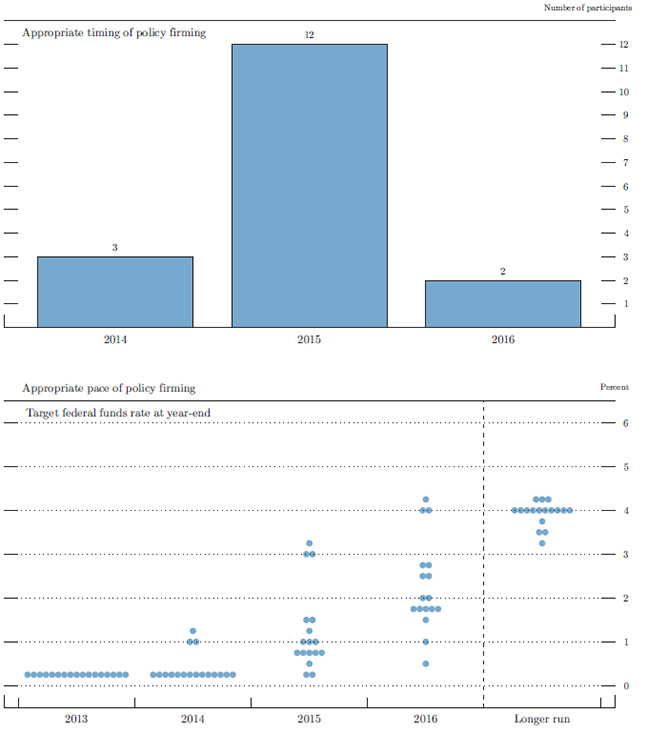
Accessible version of figure 2 | Return to figure 2
Most participants saw the uncertainty associated with their outlook for economic growth, the unemployment rate, and inflation as similar to that of the past 20 years. In addition, most participants considered the risks to the outlook for the unemployment rate and inflation as broadly balanced. A slim majority of the participants also judged that the risks to the outlook for real gross domestic product (GDP) growth were broadly balanced, while nearly as many indicated that the risks were weighted to the downside.
The Outlook for Economic Activity
Participants generally projected that, conditional on their individual assumptions about appropriate monetary policy, real GDP growth would be similar in 2013 to its rate in 2012 and would increase in the 2014-16 period to a pace above what participants saw as the longer-run rate of output growth. Many participants pointed to diminishing restraint from fiscal policy, pent-up demand for consumer and producer durables, or rising household net worth as contributing to the pickup in growth. In addition, a number of participants noted continued improvement in the housing sector, supported by rising employment and income and by improved credit availability.
The central tendencies of participants' projections for real GDP growth were 2.0 to 2.3 percent in 2013, 2.9 to 3.1 percent in 2014, 3.0 to 3.5 percent in 2015, and 2.5 to 3.3 percent in 2016. In general, participants' projections for growth in 2013, 2014, and, to a lesser extent, 2015 were below those collected in June. Most participants attributed the downward revisions to their projections in 2013 and 2014 in part to weaker-than-expected incoming data, while some participants pointed to tighter financial conditions. The central tendency for the longer-run rate of growth of real GDP was 2.2 to 2.5 percent, little changed from June.
Participants anticipated a gradual decline in the unemployment rate over the projection period. The central tendencies of participants' forecasts for the unemployment rate in the fourth quarter of each year were 7.1 to 7.3 percent in 2013, 6.4 to 6.8 percent in 2014, 5.9 to 6.2 percent in 2015, and 5.4 to 5.9 percent in 2016. These projections were little changed from June. The central tendency of participants' estimates of the longer-run normal rate of unemployment that would prevail under appropriate monetary policy and in the absence of further shocks to the economy was 5.2 to 5.8 percent. A majority of participants projected that the unemployment rate would be near or slightly above their individual estimates of its longer-run level at the end of 2016.
Figures 3.A and 3.B show that participants' views regarding the likely outcomes for real GDP growth and the unemployment rate in 2014 and 2015 remained dispersed. This diversity reflected their individual assessments of the likely rate of improvement in the housing sector and in household balance sheets, the domestic implications of foreign economic developments, the prospective path for U.S. fiscal policy, the likely evolution of financial conditions, and a number of other factors. Relative to June, the dispersions of participants' projections for GDP growth in 2014 and 2015 narrowed to some extent, while the dispersions of projections for the unemployment rate in those years generally widened a bit.
Figure 3.A. Distribution of participants' projections for the change in real GDP, 2013-16 and over the longer run*

Accessible version of figure 3.A | Return to figure 3.A
Figure 3.B. Distribution of participants' projections for the unemployment rate, 2013-16 and over the longer run*
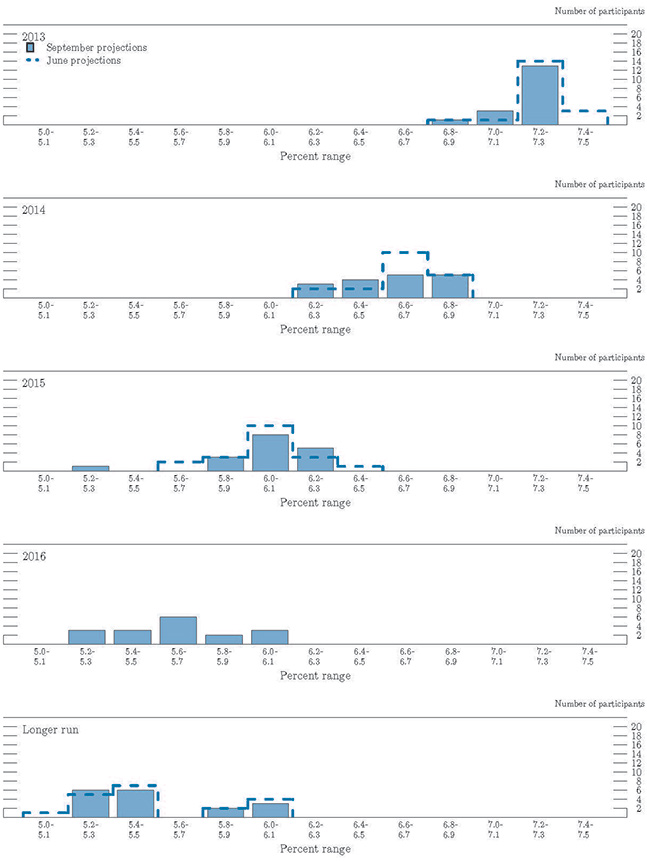
Accessible version of figure 3.B | Return to figure 3.B
The Outlook for Inflation
Participants' views on the broad outlook for inflation under the assumption of appropriate monetary policy were little changed from June. Although most participants revised up slightly their projection for PCE inflation in 2013, a number of participants revised down a bit their forecasts for 2014. All participants anticipated that both headline and core inflation would rise gradually over the next few years, and almost all participants expected inflation to be at or somewhat below the Committee's 2 percent objective in 2016. Specifically, the central tendencies for PCE inflation were 1.1 to 1.2 percent in 2013, 1.3 to 1.8 percent in 2014, 1.6 to 2.0 percent in 2015, and 1.7 to 2.0 percent in 2016. The central tendencies of the forecasts for core inflation were little changed from June and broadly similar to those for the headline measure over the projection period. A number of participants viewed the combination of stable inflation expectations and diminishing resource slack as important factors leading to a gradual pickup in inflation toward the Committee's longer-run objective.
Figures 3.C and 3.D provide information on the diversity of participants' views about the outlook for inflation. The ranges of participants' projections for overall inflation in 2014 and 2015 widened slightly from June and were 1.2 to 2.0 percent in 2014 and 1.4 to 2.3 percent in 2015. In 2016, the forecasts for PCE inflation were concentrated near the Committee's longer-run objective, though one participant expected inflation to be noticeably above the Committee's objective and another expected it to be 1/2 percentage point below. Similar to the projections for headline inflation, the projections for core inflation became more concentrated near the 2 percent objective in 2016 than in earlier years; however, the dispersion of the projections for core inflation in each year was lower than for headline inflation.
Figure 3.C. Distribution of participants' projections for PCE inflation, 2013-16 and over the longer run*
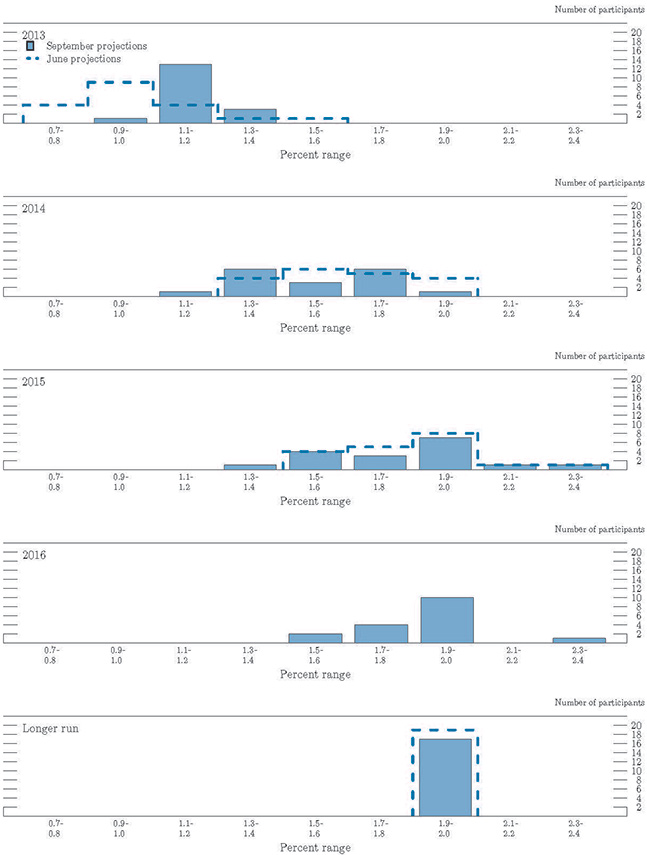
Accessible version of figure 3.C | Return to figure 3.C
Figure 3.D. Distribution of participants' projections for core PCE inflation, 2013-16*
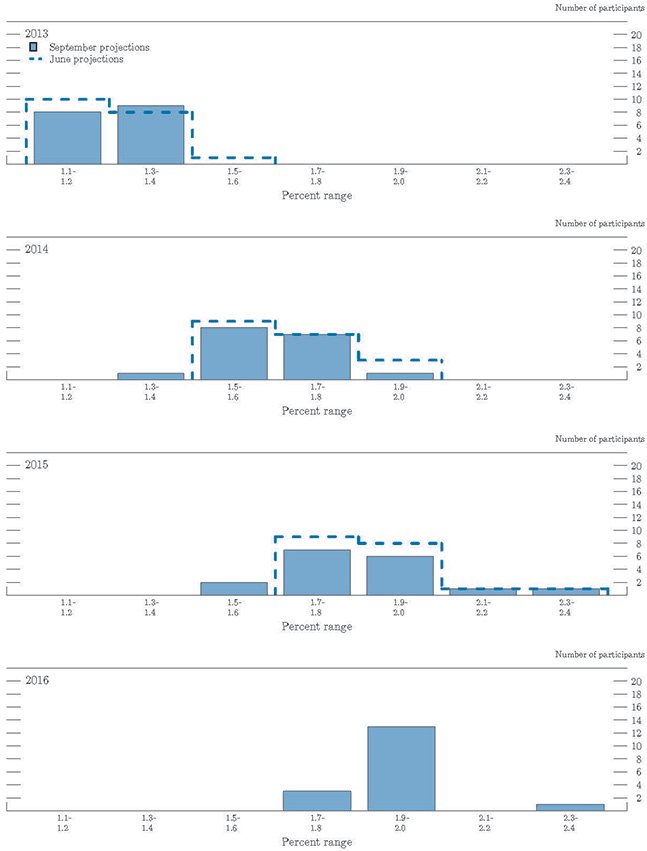
Accessible version of figure 3.D | Return to figure 3.D
Appropriate Monetary Policy
As indicated in figure 2, most participants judged that exceptionally low levels of the federal funds rate would remain appropriate for the next few years. In particular, 12 participants thought that the first increase in the target federal funds rate would not be warranted until sometime in 2015, and two judged that policy firming would likely not be appropriate until 2016. Three participants judged that an increase in the federal funds rate in 2014 would be appropriate.
All participants projected that the unemployment rate would be below the Committee's 6-1/2 percent threshold at the end of the year in which they viewed the initial increase in the federal funds rate to be appropriate, and all but one judged that inflation would be at or below the Committee's longer-run objective. Almost all participants projected that the unemployment rate would still be above their view of its longer-run level at the end of the year in which they saw the federal funds rate increasing from the effective lower bound.
Figure 3.E provides the distribution of participants' judgments regarding the appropriate level of the target federal funds rate at the end of each calendar year from 2013 to 2016 and over the longer run. As noted above, most participants judged that economic conditions would warrant maintaining the current low level of the federal funds rate until 2015. Among the three participants who saw the federal funds rate leaving the effective lower bound earlier, projections for the federal funds rate at the end of 2014 ranged from 1 to 1-1/4 percent. These three participants viewed the appropriate level of the federal funds rate as 3 percent or higher at the end of 2015, while the remainder of participants saw the appropriate level of the funds rate as 1-1/2 percent or lower. On balance, the dispersion of participants' projections for the appropriate federal funds rate at the end of 2015 widened a bit from June, while the median value of the rate was unchanged.
Figure 3.E. Distribution of participants' projections for the target federal funds rate, 2013-16 and over the longer run*
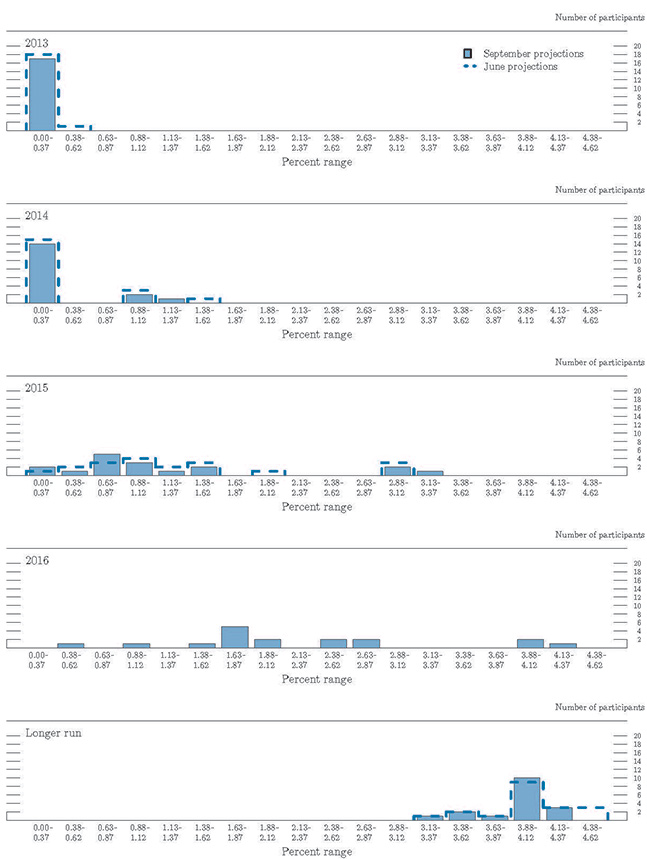
Accessible version of figure 3.E | Return to figure 3.E
All of the participants who saw the first tightening in either 2015 or 2016 judged that the appropriate level of the federal funds rate at the end of 2016 would still be below their individual assessment of its expected longer-run value. In contrast, the three participants who saw the first tightening in 2014 believed that the appropriate level of the federal funds rate at the end of 2016 would be at their assessment of its longer-run level, which they viewed as either at or just above 4 percent. Among all participants, estimates of the longer-run target federal funds rate ranged from 3-1/4 to about 4-1/4 percent, reflecting the Committee's inflation objective of 2 percent and participants' individual judgments about the appropriate longer-run level of the real federal funds rate in the absence of further shocks to the economy.
Participants also described their views regarding the appropriate path of the Federal Reserve's balance sheet. Conditional on their respective economic outlooks, most participants judged that it would likely be appropriate to begin to reduce the pace of the Committee's purchases of longer-term securities this year and to conclude purchases in the middle of 2014. A couple of participants thought it appropriate for the first reduction in the pace of asset purchases to occur later, and another specified that purchases likely would continue past midyear 2014; in contrast, a couple of participants thought that the program should be ended considerably sooner than the middle of next year.
Participants' views of the appropriate path for monetary policy were informed by their judgments on the state of the economy, including the values of the unemployment rate and other labor market indicators that would be consistent with maximum employment, the extent to which the economy was currently falling short of maximum employment, the prospects for inflation to reach the Committee's longer-term objective of 2 percent, and the balance of risks around the outlook. Some participants also mentioned the usefulness of examining the implications of alternative policy strategies for returning employment and inflation to mandate-consistent levels over the medium term.
Uncertainty and Risks
Most participants judged that the levels of uncertainty about their projections for real GDP growth and unemployment were broadly similar to the norm during the previous 20 years, although four participants continued to see them as higher (figure 4).1 The number of participants who viewed the risks around their GDP projections as weighted to the downside was nearly equal to the number who viewed them as broadly balanced. Most participants saw the risks around their unemployment projections as broadly balanced. The main factors cited as contributing to the uncertainty and balance of risks around economic outcomes were the limits on the ability of monetary policy at the zero lower bound to respond to adverse shocks, as well as challenges associated with forecasting the path of fiscal policy and developments abroad. In addition, some participants pointed to the tightening in financial conditions in recent months and the possibility of heightened volatility in financial markets, while others pointed to risks associated with structural changes affecting productivity growth and labor markets.
Figure 4. Uncertainty and risks in economic projections*
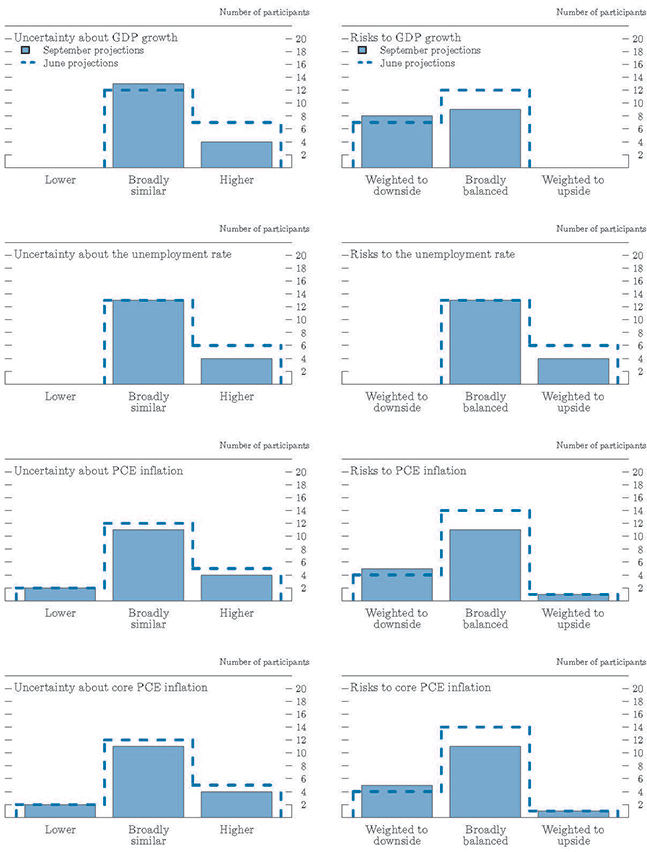
Accessible version of figure 4 | Return to figure 4
Table 2. Average historical projection error ranges
Percentage points
| Variable | 2013 | 2014 | 2015 | 2016 |
|---|---|---|---|---|
| Change in real GDP1 | ±0.9 | ±1.5 | ±1.8 | ±1.9 |
| Unemployment rate1 | ±0.3 | ±1.0 | ±1.6 | ±1.9 |
| Total consumer prices2 | ±0.8 | ±1.0 | ±1.1 | ±1.1 |
Note: Error ranges shown are measured as plus or minus the root mean squared error of projections for 1992 through 2011 that were released in the summer by various private and government forecasters. As described in the box "Forecast Uncertainty," under certain assumptions, there is about a 70 percent probability that actual outcomes for real GDP, unemployment, and consumer prices will be in ranges implied by the average size of projection errors made in the past. Further information is in David Reifschneider and Peter Tulip (2007), "Gauging the Uncertainty of the Economic Outlook from Historical Forecasting Errors," Finance and Economics Discussion Series 2007-60 (Washington: Board of Governors of the Federal Reserve System, November).
1. Definitions of variables are in the general note to table 1. Return to table
2. Measure is the overall consumer price index, the price measure that has been most widely used in government and private economic forecasts. Projection is percent change, fourth quarter of the previous year to the fourth quarter of the year indicated. Return to table
Participants reported little change in their assessments of the level of uncertainty and the balance of risks around their forecasts for overall PCE inflation and core inflation. Eleven participants judged the levels of uncertainty associated with their forecasts for those inflation measures to be broadly similar to historical norms; the same number saw the risks to those projections as broadly balanced. Five participants saw the risks to their inflation forecasts as tilted to the downside, reflecting, for example, the possibility that the current low levels of inflation could persist and become embedded in inflation expectations. Conversely, a couple of participants cited upside risks to inflation stemming from the current highly accommodative stance of monetary policy or concerns about the Committee's ability to shift to a less accommodative policy stance when it becomes appropriate to do so.
The economic projections provided by the members of the Board of Governors and the presidents of the Federal Reserve Banks inform discussions of monetary policy among policymakers and can aid public understanding of the basis for policy actions. Considerable uncertainty attends these projections, however. The economic and statistical models and relationships used to help produce economic forecasts are necessarily imperfect descriptions of the real world, and the future path of the economy can be affected by myriad unforeseen developments and events. Thus, in setting the stance of monetary policy, participants consider not only what appears to be the most likely economic outcome as embodied in their projections, but also the range of alternative possibilities, the likelihood of their occurring, and the potential costs to the economy should they occur.
Table 2 summarizes the average historical accuracy of a range of forecasts, including those reported in past Monetary Policy Reports and those prepared by the Federal Reserve Board's staff in advance of meetings of the Federal Open Market Committee. The projection error ranges shown in the table illustrate the considerable uncertainty associated with economic forecasts. For example, suppose a participant projects that real gross domestic product (GDP) and total consumer prices will rise steadily at annual rates of, respectively, 3 percent and 2 percent. If the uncertainty attending those projections is similar to that experienced in the past and the risks around the projections are broadly balanced, the numbers reported in table 2 would imply a probability of about 70 percent that actual GDP would expand within a range of 2.1 to 3.9 percent in the current year, 1.5 to 4.5 percent in the second year, 1.2 to 4.8 percent in the third year, and 1.1 to 4.9 percent in the fourth year. The corresponding 70 percent confidence intervals for overall inflation would be 1.2 to 2.8 percent in the current year, 1.0 to 3.0 percent in the second year, and 0.9 to 3.1 percent in the third and fourth years.
Because current conditions may differ from those that prevailed, on average, over history, participants provide judgments as to whether the uncertainty attached to their projections of each variable is greater than, smaller than, or broadly similar to typical levels of forecast uncertainty in the past, as shown in table 2. Participants also provide judgments as to whether the risks to their projections are weighted to the upside, are weighted to the downside, or are broadly balanced. That is, participants judge whether each variable is more likely to be above or below their projections of the most likely outcome. These judgments about the uncertainty and the risks attending each participant's projections are distinct from the diversity of participants' views about the most likely outcomes. Forecast uncertainty is concerned with the risks associated with a particular projection rather than with divergences across a number of different projections.
As with real activity and inflation, the outlook for the future path of the federal funds rate is subject to considerable uncertainty. This uncertainty arises primarily because each participant's assessment of the appropriate stance of monetary policy depends importantly on the evolution of real activity and inflation over time. If economic conditions evolve in an unexpected manner, then assessments of the appropriate setting of the federal funds rate would change from that point forward.
1. Table 2 provides estimates of the forecast uncertainty for the change in real GDP, the unemployment rate, and total consumer price inflation over the period from 1993 through 2012. At the end of this summary, the box "Forecast Uncertainty" discusses the sources and interpretation of uncertainty in the economic forecasts and explains the approach used to assess the uncertainty and risks attending the participants' projections. Return to text